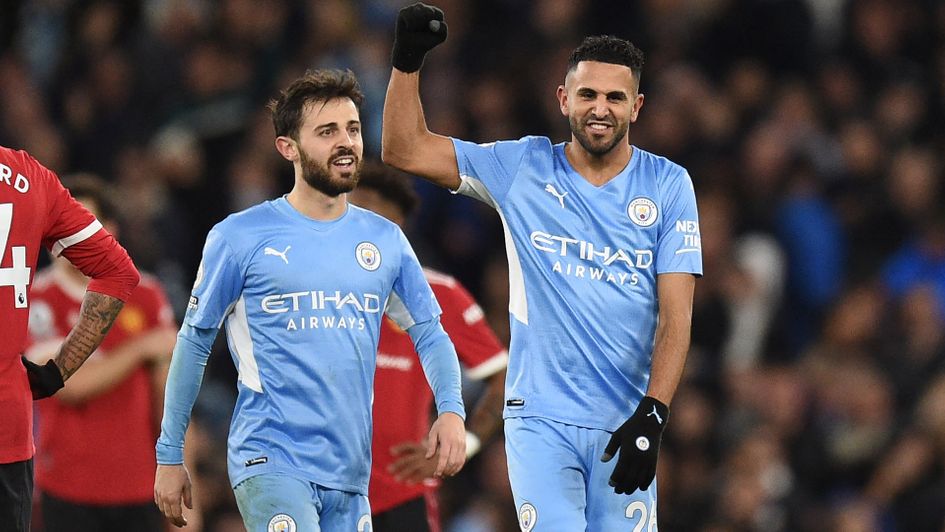Over the years, the Manchester derby has been defined by great strikers.
Sergio Aguero, Mario Balotelli, Wayne Rooney, Robin van Persie and others all made their mark on the fixture, but there wasn’t a single designated number nine on the pitch as Manchester City and Manchester United met once more on Sunday.
City’s lack of a centre forward has been a talking point all season long, at least since they failed to land Harry Kane last summer, while United’s attacking options were depleted by injury and illness.
However, only one of the two striker-less teams knew how to truly make the approach work. That team had Kevin De Bruyne.
De Bruyne scored twice and assisted another as City highlighted the gulf between themselves and their rivals. Widely revered for his creativity, the Belgian demonstrated all that he offers on a football pitch.
Nobody took more shots, both on (four) and off target (two), created more chances (five) or completed more crosses (two) than De Bruyne when he was on the pitch.
More intangible was the energy and drive he provided. Without this, Manchester City’s striker-less system could have been somewhat stagnant, but with De Bruyne creating overloads and forcing United players into difficult decisions, it was fluid and almost impossible to defend against.
Phil Foden and Jack Grealish also offered a lot, but it was De Bruyne who tied everything together.

The cohesion of City’s performance was in stark contrast to that of United’s over 90 minutes. Faced with the absence of Edinson Cavani and Cristiano Ronaldo, Ralf Rangnick opted for an unfamiliar shape and approach with Bruno Fernandes and Paul Pogba deployed through the middle as attackers.
Out of possession, United dropped into a compact 4-3-3, but on the ball the shape became a 4-2-4 with Anthony Elanga and Jadon Sancho offering width.
Had it not been for the slow, reactive defending that led to De Bruyne’s opener after just five minutes the visitors surely would have felt satisfied with their start to the match.
Without the largely immobile Ronaldo as the apex, United’s attack was nimble. Fernandes and Pogba conducted passing triangles while Elanga and Sancho did well in quick transition - see Sancho’s equaliser after 22 minutes.
Manchester United are level and it's Jadon Sancho, the former Manchester City youngster with the goal! 👀
— Sky Sports Premier League (@SkySportsPL) March 6, 2022
The Manchester United winger curls the ball home following a swift counter-attack! pic.twitter.com/TCWLyg807b
However, City started to suffocate United as the match wore on. They responded to the high line used by the away team from the start by pushing the midfield line up the pitch and trusting their technicians - the likes of De Bruyne, Grealish, Foden and Bernardo Silva - to unpick the lock in a congested area 25 yards out from goal.
The tactical baggage that has developed between these two teams was likely a factor in the lineups selected by both managers. Rangnick probably expected City to field Raheem Sterling down the left and so opted for Aaron Wan-Bissaka over Diogo Dalot to counter that threat.
Guardiola, meanwhile, anticipated this went and started Grealish who had the dribbling ability to unsettle Wan-Bissaka.
Once Manchester City got to grips with United’s unusual and uncharacteristic approach, the visitors struggled to find a way out. The hosts claimed a 92% share of possession in the final 15 minutes. United failed to muster a single shot on goal in the second half as they dramatically fell out of the contest (xG: MCI 2.61 - 0.52 MUN).
City’s superiority over United is reflected in the multi-function profile of their players. Manchester United have good players, players capable of producing individual moments of magic, but they don’t have many players who can perform a number of different roles depending on the task at-hand.
When United needed Fred and Scott McTominay to get their foot on the ball and control possession in the second half, they were unable to. When Wan-Bissaka needed to offer an outlet to relieve some of the pressure on his teammates, he couldn’t.
City, on the other hand, have plenty adaptable and intelligent players of this mould and De Bruyne is the best of the lot.
Depending on the moment of the match, the Belgian carried out his duties as a deep-lying playmaker, a box-to-box operator, a midfield anchor, a number 10, a winger and a centre forward.
He was everywhere and everything to his team. Nobody embodies Guardiola-ball better than De Bruyne, nor does anyone underline the gulf between City and United like him.













